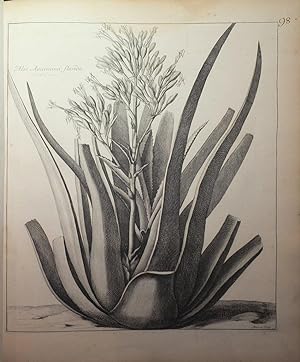dodart dionys robert nicolas (1 résultats)
Type d'article
- Tous les types d'articles
- Livres (1)
- Magazines & Périodiques
- Bandes dessinées
- Partitions de musique
- Art, Affiches et Gravures
- Photographies
- Cartes
-
Manuscrits &
Papiers anciens
Etat
- Tous
- Neuf
- Ancien ou d'occasion
Reliure
- Toutes
- Couverture rigide
- Couverture souple
Particularités
- Edition originale
- Signé
- Jaquette
- Avec images
- Sans impression à la demande
Pays
Evaluation du vendeur
-
Estampes pour servir a l'histoire des Plantes
Edité par Paris: Ca. 1719-1786, 1786
Vendeur : Arader Galleries - AraderNYC, New York, NY, Etats-Unis
Folio. (20 4/8 x 13 inches). Bound without title-page or text, as issued. 160 fine engraved plates, including 6 before letters, by Nicolas Robert, Abraham Bosse and Louis de Chatillon after Nicolas Robert and de Chatillon, with occasional engraved additions and alterations by Jean Marchant, all with early numbering in ink: 1-13, 15-159, and two bis. plates, most with Linnaean bi-nomials added in ink or pencil. Contemporary mottled calf, elegantly rebacked to style in seven compartments, with 6 raised bands, red morocco lettering-piece in one, the others decorated with small gilt tools (corners and edges expertly repaired, endpapers renewed). Provenance: with 18th-century annotations neatly supplying the Linnaean bi-nomials to many of the plates, in pen and ink, or in pencil. A RARE ALBUM OF ROBERT'S MAGNIFICENT BOTANICAL PLATES, PROBABLY BOUND FOR PRESENTATION, not formally published or offered for sale. The original intention was to publish a complete history of plants, including chemical, medical and botanical analyses of all the species. Very rarely offered for sale, and only appears in the collections of major institutions. A full suite consists of 319 engraved plates, and this album of 160 plates includes, in addition to plants from Africa and the East Indies, a large selection of plants native to the Americas, or thought to have been at the time: Hieracium caeruleum Americanum - American blue hawkweed Herba mimosa frutescens - Mimosa punctata L. - found in Texas, Central and Southern America Herba mimosa altera - Mimosa pernambucana L.- found in the West Indies Heliotropicum Americanum - Heliotropicum indicum L.- found throughout Asia Helenium Canadense, Vosacan dictum - Jerusalem artichoke Hellebornie Canadensis, sive Calceolus - Cypripedium album L. - Lady's slipper orchid - North America Muscus marinus americanus reticulatus - a type of sponge Melon vulgaris - Cacumus Melo L. - muskmelon, or cantaloupe melon Palmae nux Indicae cocciferae angulosa - Cocos nucifera L. - coconut Papauer spinosum, Mexicanum - Argemone mexicana L. - Mexican poppy Lilium sive Martagon Canadense , - Lilium superbum L. - Turkscap lily Melocactus Americanus echinatus - Cactus melocactus L. - southern United States, Mexico, Central America, Caribbean Lactuca Canadensis, altissima - Lactuca canadensis L. -Canada lettuce - 3 varieties illustrated Aloe Americana - Algarve americana L. - American aloe - 3 varieties illustrated, including Aloe vera Aster virgineaus augustifolius - New York aster Ananas Acostae Lugd. - Pineapple - South America Althea Indica Aster Canadensis - horse weed, or mare's tail - 2 varieties illustrated Apios americana - potato bean Aquitegita pumita praecox Canadensis - Aquilegia canadensis L. - Columbine Angelica trifolia, Canadensis - Angelica lucida canadensis L. - Sea angelica Apocynum American - Apocynum androsaemifolium L. - Spreading dogbane Astragalus Canadensis - Canadian milkvetch "The original idea for this encyclopaedic undertaking was conceived by Perrault and the proposal was enthusiastically received by Colbert, minister to Louis XIV, although it appears to have actually begun to take shape only when the botanist Denis Dodart (1634-1707) joined the Academie in 1673. His work, Memoires pour servir a l'Histore des Plantes, which was intended to form the introductory volume to this series, appeared in 1675 and contained thirty-nine plates by Robert. In it Dodart lamented the fact that none of the engravings could be in colour, but at least, he assured the reader, all the illustrations in the new series would be drawn directly from life, the artist making every effort to present the plants in their actual dimensions" (Lucia Tongiorgi Tomasi An Oak Spring Flora p 168). "Putting to one side his regular activity of flower painting on vellum in order to concentrate on this project, Robert managed to produce an enormous number of engravings [but at the time of his death the work was incomplete] . The Recueil des plant.


